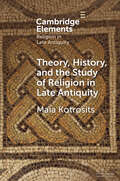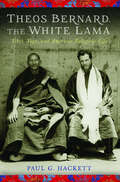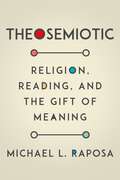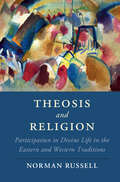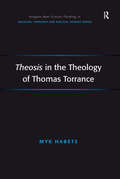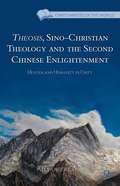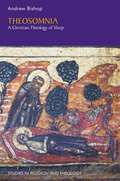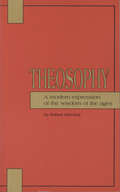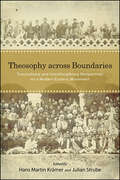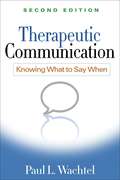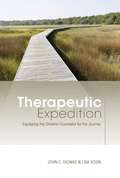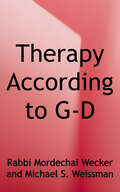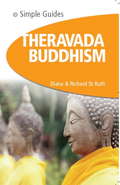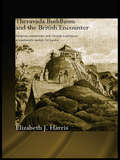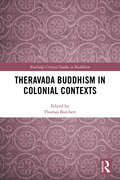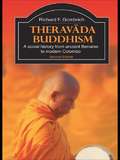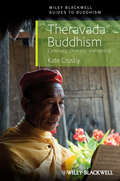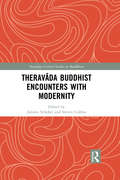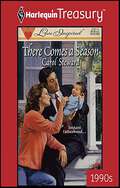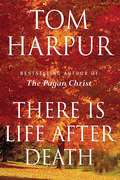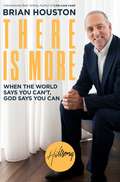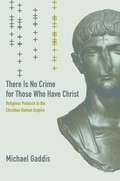- Table View
- List View
Theory, History, and the Study of Religion in Late Antiquity: Speculative Worlds (Elements in Religion in Late Antiquity)
by Maia KotrositsTheory is not a set of texts, it is a style of approach. It is to engage in the act of speculation: gestures of abstraction that re-imagine and dramatize the crises of living. This Element is a both a primer for understanding some of the more predominant strands of critical theory in the study of religion in late antiquity, and a history of speculative leaps in the field. It is a history of dilemmas that the field has tried to work out again and again - questions about subjectivity, the body, agency, violence, and power. This Element additionally presses us on the ethical stakes of our uses of theory, and asks how the field's interests in theory help us understand what's going on, half-spoken, in the disciplinary unconscious.
Theos Bernard, the White Lama: Tibet, Yoga, and American Religious Life
by Paul G. HackettThe life and adventures of an American explorer and iconic figure in the 20th century religious counterculture movement.In 1937, Theos Casimir Bernard, the self-proclaimed &“White Lama,&” became the third American in history to reach Lhasa, the capital city of Tibet. During his stay, he amassed the largest collection of Tibetan texts, art, and artifacts in the Western hemisphere at that time. He also documented, in both still photography and 16mm film, the age-old civilization of Tibet on the eve of its destruction by Chinese Communists. Based on thousands of primary sources and rare archival materials, this is the real story behind the purported adventures of Bernard and his role in the growth of America's religious counterculture. Over the course of his brief life, Bernard met, associated, and corresponded with the major social, political, and cultural leaders of his day, from the Regent and high politicians of Tibet to saints, scholars, and diplomats of British India, from Charles Lindbergh and Franklin Delano Roosevelt to Gandhi and Nehru. Although hailed as a brilliant pioneer by the media, Bernard also had his flaws. He was an entrepreneur propelled by grandiose schemes, a handsome man who shamelessly used his looks to bounce from rich wife to rich wife in support of his activities, and a master manipulator who concocted his own interpretation of Eastern wisdom to suit his ends. Bernard had a bright future before him but disappeared in India during the communal violence of the 1947 Partition, never to be seen again.&“Well-written…A readable intellectual account of the life of an ambitious Tibetological pioneer.&”—Asian Ethnology
Theos Bernard, the White Lama: Tibet, Yoga, and American Religious Life
by Paul HackettIn 1937, Theos Casimir Bernard (1908–1947), the self-proclaimed "White Lama," became the third American in history to reach Lhasa, the capital city of Tibet. During his stay, he amassed the largest collection of Tibetan texts, art, and artifacts in the Western hemisphere at that time. He also documented, in both still photography and 16mm film, the age-old civilization of Tibet on the eve of its destruction by Chinese Communists. Based on thousands of primary sources and rare archival materials, Theos Bernard, the White Lama recounts the real story behind the purported adventures of this iconic figure and his role in the growth of America's religious counterculture. Over the course of his brief life, Bernard met, associated, and corresponded with the major social, political, and cultural leaders of his day, from the Regent and high politicians of Tibet to saints, scholars, and diplomats of British India, from Charles Lindbergh and Franklin Delano Roosevelt to Gandhi and Nehru. Although hailed as a brilliant pioneer by the media, Bernard also had his flaws. He was an entrepreneur propelled by grandiose schemes, a handsome man who shamelessly used his looks to bounce from rich wife to rich wife in support of his activities, and a master manipulator who concocted his own interpretation of Eastern wisdom to suit his ends. Bernard had a bright future before him, but disappeared in India during the communal violence of the 1947 Partition, never to be seen again.Through diaries, interviews, and previously unstudied documents, Paul G. Hackett shares Bernard's compelling life story, along with his efforts to awaken America's religious counterculture to the unfolding events in India, the Himalayas, and Tibet. Hackett concludes with a detailed geographical and cultural trace of Bernard's Indian and Tibetan journeys, which shed rare light on the explorer's mysterious disappearance.
Theosemiotic: Religion, Reading, and the Gift of Meaning
by Michael L. RaposaIn Theosemiotic, Michael Raposa uses Charles Peirce’s semiotic theory to rethink certain issues in contemporary philosophical theology and the philosophy of religion. He first sketches a history that links Peirce’s thought to that of earlier figures (both within the tradition of American religious thought and beyond), as well as to other classical pragmatists and to later thinkers and developments. Drawing on Peirce’s ideas, Raposa develops a semiotic conception of persons/selves emphasizing the role that acts of attention play in shaping human inferences and perception. His central Peircean presuppositions are that all human experience takes the form of semiosis and that the universe is “perfused” with signs. Religious meaning emerges out of a process of continually reading and re-reading certain signs.Theology is explored here in its manifestations as inquiry, therapy, and praxis. By drawing on both Peirce’s logic of vagueness and his logic of relations, Raposa makes sense out of how we talk about God as personal, and also how we understand the character of genuine communities. An investigation of what Peirce meant by “musement” illuminates the nature and purpose of prayer. Theosemiotic is portrayed as a form of religious naturalism, broadly conceived. At the same time, the potential links between any philosophical theology conceived as theosemiotic and liberation theology are exposed.
Theosis and Religion: Participation in Divine Life in the Eastern and Western Traditions (Cambridge Studies in Religion, Philosophy, and Society)
by Norman RussellTheosis, originally a Greek term for Christian divinisation or deification, has become a vogue word in modern theology. Although recent publications have explored its meaning in a selection of different contexts, this is the first book to offer a coherent narrative of how the concept of theosis developed in both its Eastern and Western versions. Norman Russell shows how the role of Dionysius the Areopagite was pivotal, not only in Byzantium but also in the late mediaeval West, where it strengthened the turn towards an individualistic interiority. Russell also relates theosis to changing concepts of religion in the modern age. He investigates the Russian version of theosis, introduced in the West by Russian members the Paris School after the 1917 Revolution. Since then, theosis has undergone additional development through the addition of esoteric elements which have since passed into the mainstream of all theological traditions and even into popular spirituality.
Theosis in the Theology of Thomas Torrance (Routledge New Critical Thinking in Religion, Theology and Biblical Studies)
by Myk HabetsTorrance's vision of Theosis (deification/divinisation) is explored through his doctrine of creation and anthropology, his characterisation of the incarnation, his accounts of reconciliation and union with Christ, and his theology of church and sacraments. Myk Habets' study distinguishes Torrance's Reformed vision of theosis from other possible accounts of salvation as divinisation as they are found, for instance, within patristic thought and Eastern Orthodoxy. This book presents the first critique of the theology of T.F.Torrance to focus on theosis, and examines a model of theosis within the realm of reformed theology built upon Western theology.
Theosis, Sino-Christian Theology and the Second Chinese Enlightenment
by Alexander ChowFor a millennium and a half, Christianity in China has been perceived as a foreign religion for a foreign people. Yet in the last hundred years, various attempts to articulate a Chinese Christianity have been made by indigenous leaders like Watchman Nee, T. C. Chao and K. H. Ting. This book examines these and other historical approaches, and highlights their tendencies to draw from Western or Latin forms of Christian theology. Alexander Chow is sensitive to the ideological resources of China's past and present, and shows the potential role of Eastern Orthodox theology in today's development of an authentic Chinese contextual theology.
Theosomnia: A Christian Theology Of Sleep
by Andrew BishopSleep occupies around one third of a person's life and is the subject of research across many disciplines. In this groundbreaking new monograph, Andrew Bishop explores sleep by creatively drawing on resources of the Christian tradition. Sleep is a subject which demands theological attention, because of the central place it occupies in contemporary reflection on what it is to be human. Offering original research, this book investigates sleep for the first time from a theological position, looking at all key questions that a theological treatment of sleep raises, including issues of identity and personhood, sleep and mortality, resurrection, and renewal and healing.
Theosophy
by Robert EllwoodA professor of religion explores Theosophical ideas in modern times. Major concepts discussed include reincarnation, karma, evolution, the Oneness of all life, the cyclic nature of creation, and the mystery of consciousness.
Theosophy
by Robert EllwoodA professor of religion explores Theosophical ideas in modern times. Major concepts discussed include reincarnation, karma, evolution, the Oneness of all life, the cyclic nature of creation, and the mystery of consciousness.
Theosophy across Boundaries: Transcultural and Interdisciplinary Perspectives on a Modern Esoteric Movement (SUNY series in Western Esoteric Traditions)
by Julian Strube Hans Martin KrämerTheosophy across Boundaries brings a global history approach to the study of esotericism, highlighting the important role of Theosophy in the general histories of religion, science, philosophy, art, and politics. The first half of the book consists of seven perspectives on the activities of the Theosophical Society in very different regional contexts, ranging from India, Vietnam, China, and Japan to Victorian Britain and Israel, shedding new light on the entanglement of "Western" and "Oriental" ideas around 1900. The second half explores specific cultural influences that Theosophy exerted in the spheres of literature, art, and politics, using case studies from Sri Lanka, Burma, India, Japan, Ireland, Germany, and Russia. The examples clearly show that Theosophy was part of a truly global movement, thus providing an outstanding example of the complex entanglements of the global religious history of the nineteenth and early twentieth centuries.
Therapeutic Communication, Second Edition
by Paul WachtelA uniquely practical guide and widely adopted text, this book shows precisely what therapists can say at key moments to enhance the process of healing and change. Paul Wachtel explains why some communications in therapy are particularly effective, while others that address essentially the same content may actually be countertherapeutic. He offers clear and specific guidelines for how to ask questions and make comments in ways that facilitate collaborative exploration and promote change. Illustrated with vivid case examples, the book is grounded in an integrative theory that draws from features of psychodynamic, cognitive-behavioral, systemic, and experiential approaches. New to This Edition Reflects nearly 20 years of advances in the field and refinements of the author's approach. Broader audience: in addition to psychodynamic therapists, cognitive-behavioral therapists and others will find specific, user-friendly recommendations. Chapter on key developments and convergences across different psychotherapeutic approaches. Chapter on the therapeutic implications of attachment theory and research.
Therapeutic Expedition: Equipping The Christian Counselor For The Journey
by John C. Thomas Lisa SosinFor undergraduates and those pursuing a master's degree in counseling, psychology, social work, or pastoral counseling, Therapeutic Expedition is the only comprehensive basic helping skills textbook built upon a biblical world-view. Authors John C. Thomas and Lisa Sosin pull from their combined fifty years of clinical and classroom experience to prepare future counselors for their professional journey, fostering specific skills application in the areas of: Creating a helping relationship Assigning homework Exploring the counselee's concerns Spiritual strategies Facilitating the sessions Using metaphors Assessing the counselee The book's unique combination of qualities-a practical approach highlighting professional and personal growth based on authoritative, interdisciplinary, and biblical worldview outlooks-makes this an outstanding text within its field. Workbook excercises to foster skills application are included with each chapter.
Therapy According to G-d: A Rabbi and a Psychologist Discuss Life
by Rabbi Mordechai Wecker Michael S. WeissmanThe Torah is the Blueprint for the Universe. It is the owner's manual to life. Our mission is to learn G-d's Torah and strive to be closer to Him. Still, the Torah is even more than that. It is G-d making Himself known to the world. It has been our lifeblood for over three thousand years. It's what sustains us, keeps us alive, and gives us our sense of purpose in the world. It is eternal. It is also high drama. It is the story of relationships, conflict, and (sometimes) resolution. The Torah shares its stories to help us understand who we are and where we come from - and how we must live and grow and evolve, constantly improving ourselves, refining our character traits, and developing healthier and better relationships. Thousands of years ago and today, people have dealt with difficult issues such as anxiety, loneliness, depression, anger issues, family conflict and substance abuse. In this book, we attempt to show how eternal Torah principles can be incorporated into our daily lives - and how we can find healing and connection.
Theravada Buddhism - Simple Guides
by Diana St. RuthTHIS BOOK WILL HELP YOU* to appreciate the timeless wisdom of the oldest form of Buddhism in existence today* to understand what it means to be a Buddhist* to recognize the key practices and traditions of Theravada Buddhism* to avoid faux pas in conversation, in travelling and in personal relationshipsACCESS THE WORLD'S RELIGIONSSimple Guides: Religion is a series of concise, accessible introductions to the world's major religions. Written by experts in the field, they offer an engaging and sympathetic description of the key concepts, beliefs and practices of different faiths.Ideal for spiritual seekers and travellers alike, Simple Guides aims to open the doors of perception. Together the books provide a reliable compass to the world's great spiritual traditions, and a point of reference for further exploration and discovery. By offering essential insights into the core values, customs and beliefs of differentsocieties, they also enable visitors to be aware of the cultural sensibilities of their hosts, and to behave in a way that fosters mutual respect and understanding.
Theravada Buddhism and the British Encounter: Religious, Missionary and Colonial Experience in Nineteenth Century Sri Lanka (Routledge Critical Studies in Buddhism)
by Elizabeth HarrisThis major new work explores the British encounter with Buddhism in nineteenth century Sri Lanka, examining the way Buddhism was represented and constructed in the eyes of the British scholars, officials, travellers and religious seekers who first encountered it. Tracing the three main historical phases of the encounter from 1796 to 1900, the book provides a sensitive and nuanced exegesis of the cultural and political influences that shaped the early British understanding of Buddhism and that would condition its subsequent transmission to the West. Expanding our understanding of inter-religious relations between Christians and Buddhists, the book fills a significant gap in the scholarship on Theravada Buddhism in Sri Lanka by concentrating on missionary writings and presenting a thorough exploration of original materials of several important pioneers in Buddhist studies and mission studies.
Theravada Buddhism in Colonial Contexts (Routledge Critical Studies in Buddhism)
by Thomas BorchertOver the course of the nineteenth century, most of the Theravada world of Southeast Asia came under the colonial domination of European powers. While this has long been seen as a central event in the development of modern forms of Theravada Buddhism, most discussions have focused on specific Buddhist communities or nations, and particularly their resistance to colonialism. The chapters in this book examine the many different colonial contexts and regimes that Theravada Buddhists experienced, not just those of European powers such as the British, French, but also the internal colonialism of China and Thailand. They show that while many Buddhists resisted colonialism, other Buddhists shared agendas with colonial powers, such as for the reform of the monastic community. They also show that in some places, such as Singapore and Malaysia, colonialism enabled the creation of Theravada Buddhist communities. The book demonstrates the importance of thinking about colonialism both locally and regionally. Providing a new understanding of the breadth of experiences of Theravada and colonialism across Asia., this book will be of interest to scholars in the field of Buddhist Studies, Asian History, Comparative World History, Southeast Asian Studies and Religious Studies.
Theravada Buddhism: A Social History from Ancient Benares to Modern Colombo (The Library of Religious Beliefs and Practices)
by Richard F. GombrichWritten by the leading authority on Theravada Buddhism, this up-dated edition takes into account recent research to include the controversies over the date of the Buddha and current social and political developments in Sri Lanka. Gombrich explores the legacy of the Buddha's predecessors and the social and religious contexts against which Buddhism has developed and changed throughout history, demonstrating above all, how it has always influenced and been influenced by its social surroundings in a way which continues to this day.
Theravada Buddhism: Continuity, Diversity, and Identity (Wiley-Blackwell Guides to Buddhism)
by Kate CrosbyTheravada Buddhism provides a comprehensive introductory overview of the history, teachings, and current practice of an often misunderstood form of one of the world’s oldest religious traditions. Explores Theravada Buddhism’s origins, evolution, teachings, and practices Considers the practice of Theravada beyond Sri Lanka and Thailand, by exploring a wealth of material from countries including Bangladesh, Cambodia, and Vietnam Reveals its rich and varied traditions, and corrects common misunderstandings about links to other practices, such as early Buddhism or Hinayana Buddhism Incorporates student-friendly features including a glossary and other study aids
Theravāda Buddhist Encounters with Modernity (Routledge Critical Studies in Buddhism)
by Steven Collins Juliane SchoberAlthough recent scholarship has shown that the term ‘Theravāda’ in the familiar modern sense is a nineteenth- and twentieth-century construct, it is now used to refer to the more than 150 million people around the world who practice that form of Buddhism. Buddhist practices such as meditation, amulets, and merit making rituals have always been inseparable from the social formations that give rise to them, their authorizing discourses and the hegemonic relations they create. This book is composed of chapters written by established scholars in Buddhist studies who represent diverse disciplinary approaches from art history, religious studies, history and ethnography. It explores the historical forces, both external to and within the tradition of Theravāda Buddhism and discusses how modern forms of Buddhist practice have emerged in South and Southeast Asia, in case studies from Nepal to Sri Lanka, Burma, Cambodia and Southwest China. Specific studies contextualize general trends and draw on practices, institutions, and communities that have been identified with this civilizational tradition throughout its extensive history and across a highly diverse cultural geography. This book foreground diverse responses among Theravādins to the encroaching challenges of modern life ways, communications, and political organizations, and will be of interest to scholars of Asian Religion, Buddhism and South and Southeast Asian Studies.
There Comes a Season
by Carol StewardA SEASON FOR LOVE?When he discovered his infant son, Bryan Beaumont was consumed with self-doubt. What did a high-flying executive know about parenting?But compassionate day-care working Laura Bates simply wouldn't allow a disillusioned Bryan to lose faith in himself-or his baby.While Laura knew the good Lord wanted her to help unite father and son, she felt far too vulnerable to open her heart to this dynamic and demanding man. Still, Bryan's tender smile stirred emotions she thought were gone forever. Would the coming season restore her hope for a joyous future?Welcome to Love Inspired™-stories that will lift your spirits and gladden your heart. Meet men and women facing the challenges of today's world and learning important lessons about life, faith and love.
There Is Life After Death
by Tom HarpurWhat happens when we die? Will we simply dissolve into nothingness, or will we survive death in some other form? Issues of death and dying have consumed humanity from time immemorial. In our modern western culture, we have tended out of fear to deny and push death away. And yet, a healthy consideration of this issue can help us embrace and understand what happens to us when we die. There is Life After Death is Tom Harpur’s classic examination of death and dying. Now fully revised and updated, here is a new edition of a book that weighs the scientific, religious and anecdotal evidence of survival of death and what happens after we die. The likelihood of death being a portal to other forms of existence is argued persuasively. Tom Harpur looks at the witness of near-death experiences, and examines the idea of reincarnation, as well as the claims of channelers and spirit mediums. Most importantly, the author looks at how the great world religions from Christianity, Judaism and Islam to Hinduism, Buddhism and Native Spirituality among others, deal with life after death. This book is a powerful summary of what we know and believe about death. There is Life After Death is both illuminating and comforting in its message and conclusions — and goes a long way in putting to rest one of the last great taboos of our culture.
There Is More: When the World Says You Can't, God Says You Can
by Brian HoustonFounder and Global Senior Pastor of Hillsong Church and author of LIVE LOVE LEAD shows how, with God's power, you can believe and achieve a life that exceeds every earthly expectation. When you surrender control and follow God's guidance, you become empowered and equipped to do the impossible, reach higher, and go further than you could have ever imagined--giving Him all the glory.By building our lives around godly principles, surrounding ourselves with wisdom, and living for a cause greater than ourselves, we can effectively live out God's purposes and have an enduring impact. As Brian Houston has personally discovered, when we depend on Jesus as the source for our identity, our lives can be a lasting legacy that maximize the gifts He has given each of us as unique individuals. There is More is for anyone who wants to be challenged to live with expectancy. Ephesians 3 is a call to release the immeasurable potential within you and the exceeding, abundant, and above plans and purposes of a Holy God that are beyond your greatest imagination. "Now to Him who is able to do exceedingly abundantly above all that we ask or think, according to the power that works in us, to Him be glory in the church by Christ Jesus to all generations, forever and ever. Amen" (Ephesians 3:20-21).
There Is No Crime for Those Who Have Christ: Religious Violence in the Christian Roman Empire
by Michael GaddisThis is a book about violence, its reality, its perceptions, and its consequences. It takes as its premise that violent acts cannot be understood apart from the moral and ideological context in which they take place. It seeks to approach the problem from multiple perspectives, illuminating the views and voices of both violent actors and victims, of apologists, observers, and opponents both praising and condemning the same deeds.
There Is No God and He Is Always with You: A Search for God in Odd Places
by Brad WarnerCan you be an atheist and still believe in God? Can you be a true believer and still doubt? Can Zen give us a way past our constant fighting about God? Brad Warner was initially interested in Buddhism because he wanted to find God, but Buddhism is usually thought of as godless. In the three decades since Warner began studying Zen, he has grappled with paradoxical questions about God and managed to come up with some answers. In this fascinating search for a way beyond the usual arguments between fundamentalists and skeptics, Warner offers a profoundly engaging and idiosyncratic take on the ineffable power of the “ground of all being.”
